FRIENDS! We are so thrilled that the Book Maker's Dozen will be here tomorrow. Some of them spoke to us on Friday at the Marketing Intensive for Illustrators. We didn't want to give too much of it away on the blog, but we do want you to see Dan Yaccarino's fantastic trailers for one of his impeccable-as-always books, ALL THE WAY TO AMERICA!
Catch Dan Yaccarino, John Rocco, Sophie Blackall, Selina Alko, Sean Qualls, Peter Brown, John Bemelmans Marciano, Sergio Ruzzier, Brian Floca, David Gordon, Aileen Leijten and Brett Helquist on Sunday at 9:15 in the AM!
Ooo, and more of Yaccarino's awesome trailers:
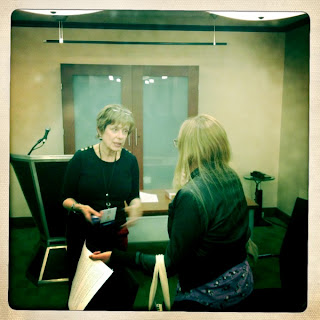 |
| That's not a conference badge—that's a knife! Sarah Davies with her latest victim |
Sarah Davies is a thriller addict. Her first taste was as a kid in England, she loved books by Willard Price, Agatha Christie. Some of you purists will say those are adventures and murder mysteries, not thrillers, but Sarah is here to tell us that action and ammunition alone will not make a good thriller, they need mystery and intrigue.
How do you make a thriller for kids? It's easier to do in young adult: YA thrillers can have elements of sexy romance, and bloodier action, which allows for bigger stakes.
A middle grade thriller is more action adventure, clue solving, and platonic friend relationships, with external vs. internal danger taking main roles in building the book's thrills.
The best thing you can do to learn how to write a great thriller is to read a great thriller, here are two Sarah recommends (and reps!) (Sarah also gave attendees a great handout on tips for thriller writing.)
Sarwat Chadda's (available in UK, edited by fellow faculty member Cheryl Klein for forthcoming edition) SAVAGE FORTRESS:
Jennifer Laughran joined Andrea Brown Literary Agency in 2007. Her clients include Daniel Pinkwater, Calef Brown, Matt Faulkner, Jackie Dolamore, Ilsa J. Bick, Eric A. Kimmel, L.K. Madigan, Adam Selzer, Tara Kelly and Kate Messner, and many excellent debut authors.
 |
| Jennifer Laughran speaking to a packed room |
Jennifer starts her session with sharing her background. She was a bookseller (her family owns an independent bookstore), then a buyer for a major bookstore and an events coordinator.
She became an agent in 2007 and finds the jobs are very similar – matching the right books to the right people… just in a more macro way.
Andrea Brown Literary has nine agents, Jennifer is their NY agent (the main office is in the San Francisco bay area.
They're the #1 children’s agency in the country, and they only represent children’s, PB to YA
Her focus is MG and YA
with a few authors who do PB also,
and a few author/illustrators.
Jennifer has a wonderful blog
here's the link and has sold 78 books as of this month since 2008! (27 or so are out already.)
She covers a number of different metaphors and definitions of fiction, positing that fiction is always true, some element of truth, some part of the human condition that you’re exposing – that’s where “write what you know” comes in. It means “write what you know about the human condition to be true.”
She talks about many of the “rules” as a reader, and how you really need to ignore the rules.
A writing tip via author Holly Black:
“Write to please a reader self and not a writer self.”
Jennifer explains that means don’t write things that are boring.
“If you do get dressed in the morning, don’t tell me about it, I’ll take it on faith.” Tell her about what happens when you leave the house and have an adventure.
Her Advice:
Write the book that you would have held close to your heart when you were a kid,
a book that only you can write.
Trends?
“trends suck. I hate them. I think you should be setting trends, not following them.”
The fact that the marketplace has contracted is a good thing for readers, but it’s tough for writers, means we have to work that extra hard. But she praises those of us here doing our work, saying we’re already one step ahead.
She’s running down different kinds of MG and YA books, and urges us to figure out how to differentiate our take on the subject if we’re going to write in a genre that’s well-known. Writing about vampires? How do you have a different take on it?
She explains how each of us can find our voice, defines high concept, and tells us
“There’s always a market for awesome books.”
Her tastes are “at the intersection of beautifully written and highly commercial,” saying the greater a manuscripts un-put-down-ability, the easier it is to sell, and that’s the book she wants to represent. She adds, “I am always interested in fresh unique funny MG and
mysterious, scary YA.”
She took a lot of questions from a very enthusiastic and interested audience, making us laugh many times and sharing so much great information.
Cathy Goldsmith delighted session attendees with a multi-page handout outlining the key steps an illustrator goes through in their career, from submitting portfolios to going on a book tour. Here's a sneak at a point from each section:
Making portfolios (front load your portfolio with your best work!)
Starting to work on a picture book (ask about what type of binding will be used or whether you'll have illustrated endpapers!)
Considerations while working on a picture book (don't forget the gutter!)
Process (how many rounds of sketches will you need to get to final art?)
After publication (you might be asked to do additional artwork for print or online ads, be ready and willing!)
I'm a sucker for children's book historians (I have a Leonard Marcus cardboard cutout in my office!) and Martha Rago starts this session off with words from a favorite. A TOTAL CHILDREN'S BOOK BAD(er)ASS, Barbara Bader. Barbara contributes to THE
HORN BOOK, which should be the first magazine you
subscribe to if you are serious about having a career in children's books.
She's also the author of the excellent AMERICAN PICTURE BOOKS: FROM NOAH'S ARK TO THE BEAST WITHIN, a book well worth the wait and weight if you can find a copy. Martha riffs off a quote of Barbara's to get us thinking about what illustrators need to do make their final artwork sing and the resulting picture book stand out.
Here are two of those things, briefly:
1. Consistency of style. You can have more than one style, but they must all be strong and consistent. Martha's examples of illustrators with consistent styles:
 |
| Paul Schmid |
 |
| Kadir Nelson |
![]()
Cassandra Clare is the bestselling author of The Mortal Instruments and The Infernal Devices series. A strong theme of forbidden love runs through her books. Readers go where the tension is, but readers also love romance. The path of love does not run smooth. Love can be forbidden in several ways: by family, by society/taboo, or it can be unsuitable or dangerous in some manner.  Don't be afraid to create really big obstacles because it creates higher and higher stakes for your characters. "The bigger the obstacles, the bigger the love needed to overcome them." Love triangles are extremely popular. It's been part of our storytelling culture for hundreds of years. Some pitfalls of the love triangle: *Epic language, like "I will always love you." *Indecision *Having a love V, rather than a triangle because two characters don't have any connection. "The kind of love story that is fun to live, is not fun to read about."
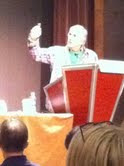 | | Bigger-than-life Henry Winkler. The photo is smaller than life. |
Henry Winkler appears on the dais! He's funny, and speaks of having co-written 19 books with Lin Oliver, being an actor and director and producer... even though he was never a good student. They hatched the idea for Frank Zipster, and he's explaining their collaborative process. "If you write what you know, not what you think other people will read or are selling or want to hear... if you write what you know, it jumps off the page." He's very encouraging and inspirational, the crowd is laughing... He gets a huge round of applause and the crowd are on their feet!
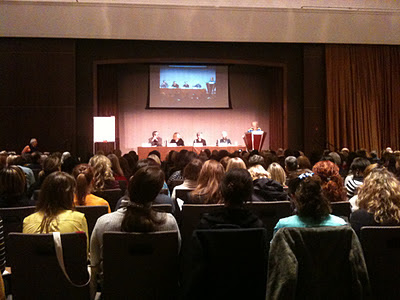 | | from left to right: Rubin Pfeffer, Barbara Marcusw, Jean Feiwel, Nancy Paulsen and Lin Oliver at the podium |
The morning panel is starting - we at Team Blog will be publishing four separate posts, so you can get the best of what each of these experts has to share: Jean Feiwel, Senior Vice President and Publishing Director, Feiwel and Friends (MacMillan) Barbara Marcus, Strategic Innovations Advisor Nancy Paulsen, President and Publisher, Nancy Paulsen Books (Penguin) and Rubin Pfeffer, Agent, East West Literary Agency
Chris Crutcher is the author of fourteen books -- eleven novels, two short story collections and an autobiography. He is also one of the most frequently banned authors in North America -- a fact he considers an accomplishment, rather than a drawback. Chris has been awarded the NCTE's National Intellectual Freedom Award, the ALAN Award, the ALA's Margaret A. Edwards Lifetime Achievement Award, the CLA's St. Katharine Drexel Award and Writer magazine's Writers Who Make a Difference Award.
 | | Chris Crutcher giving his opening Keynote at #NY12SCBWI |
To a sold out room of over 1,100 rapt writers and illustrators, Chris is telling us about his background and childhood. He worked as a therapist with troubled youth (dealing with child abuse and neglect and illness) for over 20 years, and he couldn't use those stories, but after a while the underlying truths became the stuff of his fiction. He's sharing where the narrative voice came from for his books, and then the inspiration for and genesis of the character Ben Wolf from his novel, "Deadline." He's reading an excerpt from the book now. The room is still, listening to the words. Moved. Drawn in by the spell of it. On the verge of tears, and then laughing. And then, Chris says, I love to make people laugh, and I love to make people cry, but what I want is for someone to read my books and go, Yeah, I get it." That spiritual connection, the "what is the book about." And he's sharing with us the moment he realized "Deadline" was about grief. He's telling us the story of a child he encountered dealing with grief, and those of us in the room are rocked to our cores. "The language of grief, and hard times can be pretty rugged, and we as writers need to tell them in their native tongue." And one of Chris' best tips: "If you're going to go down the tragic road, you want to go just as far down the comic road," explaining that you need to balance them out. The room is up on their feet - an incredible opening keynote!
Have you been taking great photos of your friends at the New York conference? Post them to the first-ever photoblog.
It's easy:
From a mobile phone, share your photos via email by sending them to:
[email protected]
(The body text of the email will become the caption, not the subject.)
Or, from a computer, click here!
Enjoy the photos, and (to be read in the voice of a stern mother) use your best judgment when you post.
 | | Writers and Illustrators arriving and checking in for the sold out day of intensives! |
The energy is palpable at reception. Writers and Illustrators are gathering from all over the world. 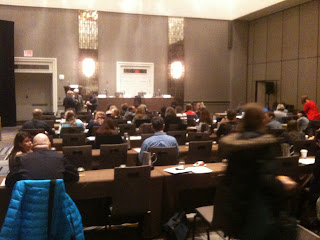 | | The Illustrators Marketing Intensive room filling up |
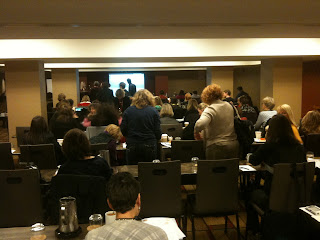 | | Writers taking their seats at the Writers Marketing Intensive |
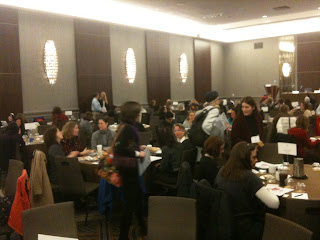 | | Writers finding their tables at the Writers Roundtable Intensive |
To dig deep for knowledge. To soar with new understanding and skills. And Team Blog is here. We'll be sharing some highlights and impressions from each of the three sessions: The Writers Roundtable The Writers Marketing Intensive and The Illustrators Marketing Intensive. Illustrate and Write and Let's get our Conference On!
Team Blog's Martha Brockenbrough interviews agent Rubin Pfeffer to get the inside scoop on his E-books and Apps Breakout workshops on the conference Saturday - January 28, 2012.
Rubin is a veteran of the children’s and adult trade industry, a visionary who's working on - as they used to refer to it when I was in grad school - the "bleeding edge of technology." He has served as President and Publisher of Harcourt Brace Jovanovich, SVP and Chief Creative Officer of Pearson, and as SVP, Publisher of Children’s Books for Simon & Schuster. Pfeffer joined the East West Literary Agency in December 2009, as a partner and established the Boston base of the agency. He works with such luminary talents as Patricia MacLachlan, Marion Dane Bauer, Steven Kellogg, Susan Cooper, Judy Sierra, David Diaz, Richard Jesse Watson, Jesse Joshua Watson, Jeff Mack, Mike Austin, and a host of other published and new talents. In addition, he consults regularly on digital content for the Ruckus Media Group. In the interview, Rubin also put out a call for readers to nominate our favorite book apps in the comments, so he can share and build on what we all have to say when he does his presentations. See how innovative and cutting edge he is? So head on over to Martha's blog and check it out. It's a taste of one more amazing offering at the upcoming Lucky 13th Annual Winter Conference. You can find out more and register here. Hope to see you in New York. Illustrate and Write On,Lee
I got to sit down with Lin Oliver, SCBWI's Executive Director, and learn why the new Illustrator's Marketing Intensive coming up on the Friday before the full 2012 SCBWI Winter Conference isn't just going to be great - it's going to be essential.
You can register now for the Illustrator's Marketing Intensive and the whole Lucky 13th Annual SCBWI Winter Conference!
Hope to see you there,
Namaste,
Lee
|



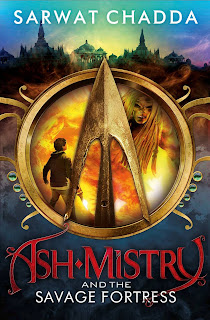








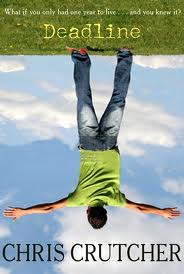
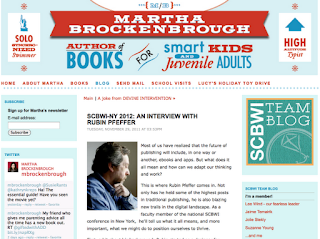
I wish I could have been there! This is great information for writers. Thanks!